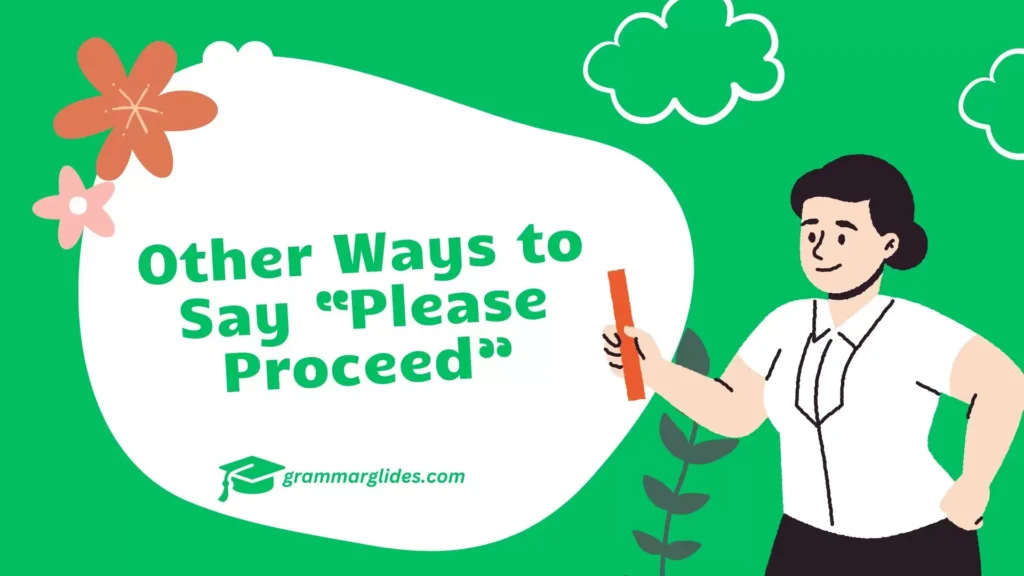When you’re in a position to direct or encourage someone to continue, the phrase “Please proceed” is often a go-to choice.
However, there are many other ways to convey the same message that can add a bit of variety, formality, or encouragement depending on the situation.
In this guide, we’ll explore 30 alternative ways to say “Please proceed,” with scenarios and examples to help you find the perfect phrase for every occasion.
1. Continue When Ready
Scenario: Polite and casual encouragement during a meeting.
- Example 1: “Whenever you’re ready, continue when ready.”
- Example 2: “Feel free to continue when ready.”
Explanation: This phrase is a gentle and polite way to invite someone to proceed at their own pace, making it ideal for relaxed or informal settings.
2. Go Ahead
Scenario: Simple, direct instruction.
- Example 1: “If everything’s set, go ahead.”
- Example 2: “Please, go ahead with your presentation.”
Explanation: “Go ahead” is straightforward and to the point, making it a versatile option for various situations where you want someone to continue quickly.
3. You May Proceed
Scenario: Formal or official instructions.
- Example 1: “All documents are in order; you may proceed.”
- Example 2: “You may proceed with the next steps now.”
Explanation: This phrase is ideal for formal or professional contexts, conveying authority while remaining polite.
4. Please Continue
Scenario: Encouraging someone to keep going.
- Example 1: “Your ideas are great, please continue.”
- Example 2: “We’re all ears, please continue with your thoughts.”
Explanation: “Please continue” is a warm and inviting way to ask someone to keep going, often used to show interest in what they’re saying.
5. Feel Free to Proceed

Scenario: Allowing someone to continue with freedom.
- Example 1: “Everything’s in place, feel free to proceed.”
- Example 2: “Feel free to proceed when you’re comfortable.”
Explanation: This phrase gives the other person control over when they continue, making it useful in collaborative or flexible environments.
6. Let’s Move Forward
Scenario: Encouraging progress in a discussion or project.
- Example 1: “That’s a great start; let’s move forward.”
- Example 2: “We’re on the right track; let’s move forward with the plan.”
Explanation: “Let’s move forward” is an encouraging phrase that helps to maintain momentum and focus on progress.
7. Go On
Scenario: Casual and informal settings.
- Example 1: “Interesting point, go on.”
- Example 2: “Go on, I’m listening.”
Explanation: “Go on” is a simple, informal way to encourage someone to keep speaking or working, often used in everyday conversations.
8. Proceed When You’re Ready
Scenario: Offering the other person control over the timing.
- Example 1: “No rush, proceed when you’re ready.”
- Example 2: “Take your time, and proceed when you’re ready.”
Explanation: This phrase is polite and gives the speaker or worker the freedom to continue at their own pace.
9. Let’s Proceed
Scenario: A collaborative approach to moving forward.
- Example 1: “We’ve agreed on the plan; let’s proceed.”
- Example 2: “With everything in place, let’s proceed.”
Explanation: “Let’s proceed” fosters a sense of teamwork and shared action, making it ideal for group settings.
10. Continue as Planned
Scenario: Following a set plan or schedule.
- Example 1: “We’re on schedule, continue as planned.”
- Example 2: “No changes needed, continue as planned.”
Explanation: This phrase is useful in structured environments where following a plan is crucial.
Other Ways to Say “Why Do You Ask?”
11. Take the Next Step
Scenario: Moving to the next phase in a process.
- Example 1: “Great work so far, take the next step.”
- Example 2: “You’ve got the green light, take the next step.”
Explanation: “Take the next step” encourages action and progression, perfect for project management or step-by-step tasks.
12. Feel Free to Continue
Scenario: Allowing the other person to proceed comfortably.
- Example 1: “We’re ready for the next part, feel free to continue.”
- Example 2: “Feel free to continue whenever you’re set.”
Explanation: This phrase is friendly and non-pressuring, making it suitable for relaxed or supportive environments.
13. Carry On
Scenario: A brisk and authoritative instruction.
- Example 1: “Everything’s clear, carry on.”
- Example 2: “No issues here, carry on with your work.”
Explanation: “Carry on” is direct and no-nonsense, often used in more formal or structured settings.
14. Whenever You’re Ready
Scenario: Giving the other person control over the timing.
- Example 1: “We’re in no hurry, whenever you’re ready.”
- Example 2: “Whenever you’re ready, feel free to proceed.”
Explanation: This phrase is flexible and considerate, offering the speaker or worker the freedom to continue at their own pace.
15. Move On
Scenario: Transitioning to the next topic or task.
- Example 1: “We’ve covered this part, let’s move on.”
- Example 2: “It’s time to move on to the next point.”
Explanation: “Move on” is a decisive phrase that helps shift focus to the next stage or subject.
16. Let’s Continue
Scenario: Encouraging teamwork in moving forward.
- Example 1: “We’re making progress; let’s continue.”
- Example 2: “With that settled, let’s continue with the agenda.”
Explanation: “Let’s continue” is inclusive and motivating, ideal for group discussions or projects.
17. You Can Go Ahead Now
Scenario: Granting permission to proceed.
- Example 1: “Everything’s set, you can go ahead now.”
- Example 2: “No further questions, you can go ahead now.”
Explanation: This phrase is clear and gives the person the green light to continue, useful in formal or structured scenarios.
18. Proceed with the Next Step
Scenario: Following a step-by-step process.
- Example 1: “We’re ready, proceed with the next step.”
- Example 2: “Please proceed with the next step in the process.”
Explanation: This phrase is systematic and organized, making it perfect for task-oriented settings.
19. Let’s Keep Going
Scenario: Encouraging continuation without stopping.
- Example 1: “This is going well, let’s keep going.”
- Example 2: “We’re on a roll, let’s keep going.”
Explanation: “Let’s keep going” is motivational and helps maintain momentum in a task or discussion.
20. Onward
Scenario: Inspirational and forward-thinking.
- Example 1: “We’ve come this far, onward!”
- Example 2: “There’s no turning back, onward to the next challenge.”
Explanation: “Onward” is a powerful and inspiring phrase, perfect for motivating a team or individual to continue with determination.
21. Please Continue with Your Work
Scenario: Giving permission to resume a task.
- Example 1: “All clear now, please continue with your work.”
- Example 2: “No further interruptions, please continue with your work.”
Explanation: This phrase is polite and respectful, making it suitable for professional settings.
22. Go On When Ready

Scenario: Allowing the other person to choose the timing.
- Example 1: “We’re ready when you are, go on when ready.”
- Example 2: “No rush, go on when ready.”
Explanation: “Go on when ready” is considerate and flexible, ideal for situations where timing can be left to the other person’s discretion.
23. Let’s Take the Next Step
Scenario: Moving forward in a process.
- Example 1: “Great progress so far, let’s take the next step.”
- Example 2: “With the groundwork laid, let’s take the next step.”
Explanation: This phrase encourages progress and is particularly useful in project management or procedural tasks.
24. Please Proceed with the Next Item
Scenario: Structured meeting or agenda.
- Example 1: “We’re ready for the next point, please proceed with the next item.”
- Example 2: “Please proceed with the next item on the agenda.”
Explanation: This phrase is formal and structured, perfect for meetings or organized discussions.
25. We’re Ready for the Next Part
Scenario: Transitioning to the next section of a task or presentation.
- Example 1: “That was insightful, we’re ready for the next part.”
- Example 2: “Let’s move on; we’re ready for the next part now.”
Explanation: “We’re ready for the next part” signals readiness to continue and is effective in guiding transitions in a meeting or project.
26. Let’s Push Forward
Scenario: Encouraging determination and persistence.
- Example 1: “Challenges ahead, but let’s push forward.”
- Example 2: “No time to waste, let’s push forward with the plan.”
Explanation: “Let’s push forward” is motivational and encourages perseverance, suitable for challenging tasks or situations.
27. Shall We Continue?
Scenario: Inviting others to proceed together.
- Example 1: “We’ve covered a lot, shall we continue?”
- Example 2: “If everyone’s ready, shall we continue with the discussion?”
Explanation: “Shall we continue?” is polite and inclusive, often used to invite others to proceed as a group.
28. Feel Free to Go Ahead
Scenario: Granting permission in a relaxed setting.
- Example 1: “If everything’s clear, feel free to go ahead.”
- Example 2: “Feel free to go ahead whenever you’re ready.”
Explanation: “Feel free to go ahead” is informal and inviting, making it ideal for relaxed or supportive environments.
29. You’re Good to Go
Scenario: Confirming readiness to proceed.
- Example 1: “Everything’s set, you’re good to go.”
- Example 2: “No issues here, you’re good to go.”
Explanation: “You’re good to go” is reassuring and confident, often used to confirm that everything is in place for the other person to continue.
30. Take It Away
Scenario: Handing over control to someone else.
- Example 1: “The stage is yours, take it away!”
- Example 2: “You know what to do, take it away from here.”
Explanation: “Take it away” is enthusiastic and empowering, making it perfect for situations where you want to encourage someone to take charge.
Conclusion
In any conversation or professional setting, how you ask someone to continue can greatly impact the tone and flow of the interaction.While “Please proceed” is a perfectly polite and effective phrase, having a variety of alternatives allows you to tailor your communication to different contexts, whether they are formal, informal, encouraging, or directive.
By using these 30 different ways to say “Please proceed,” you can add nuance to your language, making your requests clearer and more engaging.Whether you’re leading a meeting, encouraging a team member, or simply guiding a discussion, choosing the right phrase can help you communicate more effectively and keep things moving smoothly.

Hi! I’m Lauren Reynolds, the author of Grammar Glides. I create easy-to-follow content that helps you master English with confidence. Let’s make learning English simple and enjoyable together!

